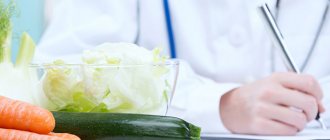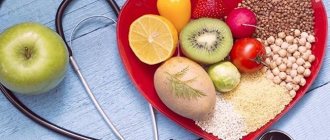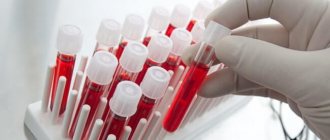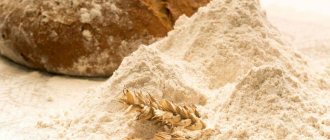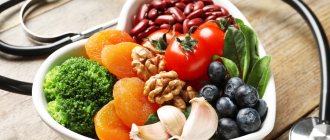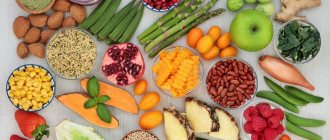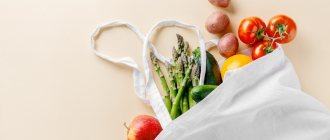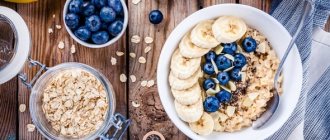There are a lot of drugs to lower blood sugar levels, from cheap tablets to modern insulins in special devices. Sometimes you want to understand the doctor's prescriptions. What if there is a better drug?
Get all the necessary tests at a discount of 10% to 25% using the promotional code “MOESHEALTH”. Visit one of the many conveniently located KDL medical offices https://bit.ly/3gIM9wP or call a nurse for free to collect biomaterial using the innovative laboratory service LifeTime https://bit.ly/3yd9Pj2
Diabetes and diet: everything is mixed with sugar
One of the main myths circulating on the Internet: a diabetic cannot eat food with carbohydrates! In fact, if you refuse such food, you can very quickly go “to the next world.” As well as eating too much of it. To understand what the catch is, you need to understand the concept of “diabetes”.
In a nutshell, the disease can be characterized as follows: diabetics have a metabolic disorder due to problems with the production of the hormone insulin, which is responsible for the absorption of sugar. Sugar (glucose) serves as food for all cells of the body - it provides energy. There is no insulin - sugar does not enter the cells, but accumulates, poisoning the body. In other words, there is no life without sugar, and the problem with diabetes is that it ends up in the wrong places.
You may ask, what does diet have to do with it if the disease is not “from food”? It's simple! There are 2 types of diabetes:
- In type I diabetes, insulin is not produced at all - this is insulin-dependent diabetes. To improve the condition, diabetics with this form of the disease are prescribed insulin in tablets or injections. Such patients need a diet so as not to exceed the dose of sugar that can be absorbed by the administered insulin.
- In type II diabetes, insulin is produced, but the cells do not perceive it well - this is non-insulin-dependent diabetes. In this case, insulin is not prescribed, and health must be maintained with a diet that limits carbohydrates to the extent that the body can cope with them.
In diabetes, the body cannot absorb large amounts of sugar, but at the same time it cannot do without glucose. This means that a diabetic’s diet should be planned in such a way that glucose is supplied in small portions, but often. Plus, it is very important that it is in an accessible form.
How to avoid diabetes, 13 ways
This leaves many wondering how to minimize the risks of developing diabetes. Prevention is the best way to preserve both your own health and that of your loved ones. This aspect is especially important given that many people are predisposed to the disease. This means that sugar is high, but has not yet reached the level when the patient is diagnosed with diabetes.
Prevention of diabetes
Seventy percent of people with a predisposition to this disease may develop type 2 diabetes. However, by taking certain steps, this can be avoided. It will not be possible to influence age, genes, or lifestyle prior to the moment when a person decides to pay increased attention to his health, but everyone can eliminate certain bad habits and acquire useful ones that help minimize the risks of developing the disease.
#1 Avoid refined carbohydrates and sugar
Reviewing your diet is the first step towards preventing diabetes. Foods in which sugar and refined carbohydrates are present in large quantities can give a significant impetus to the development of the disease. Sugar molecules formed as a result of the breakdown of such products enter directly into the circulatory system. This causes a sharp increase in blood sugar levels and the synthesis of insulin, a hormone produced by the pancreas that performs a “transport” function, as a result of which sugar from the blood enters other cells.
Insulin is not accepted by the body of people with a predisposition to diabetes, and, instead of being distributed, sugar obtained from “junk” food remains entirely in the blood. The pancreas, trying to restore balance, begins to produce insulin even more actively. This does not lead to normalization of sugar, but, on the contrary, increases it even more. In addition, the amount of insulin begins to go off scale. Such a scheme becomes the impetus for the development of diabetes.
The existence of a connection between the consumption of foods rich in refined carbohydrates and sugar and an increase in the likelihood of illness has been proven in various studies. If you refrain from eating such foods, this risk is significantly minimized. Of the thirty-seven studies conducted to date, all have confirmed that people who eat fast carbohydrates are forty percent more likely to develop diabetes.
#2 Exercise regularly
Physical activity increases the sensitivity of cells to insulin, which allows the pancreas not to produce this hormone in large quantities, and, therefore, maintaining sugar levels becomes much easier. Doesn't necessarily become a professional athlete. The main thing is to simply do various exercises. Scientists have found that high-intensity exercise increases the body's sensitivity to insulin by 85 percent, and moderate-intensity exercise increases the body's sensitivity to insulin by 51 percent. The effect, unfortunately, only lasts on training days.
Engaging in various types of physical activity lowers sugar levels not only in people predisposed to diabetes, but also in obese people. Strength, high-intensity and aerobic training gives this result. If you make sports a part of your life, insulin will begin to be produced without any disturbances. This result can be achieved by increasing the number of calories burned during exercise to two thousand per week. To make this easier to achieve, you should choose exactly the type of activity that you like most.
#3 Make water the main source of fluid intake
You should not get carried away with various drinks. They, unlike ordinary drinking water, especially store-bought ones, contain sugar, preservatives and other additives not always known to the buyer. Drinking carbonated drinks increases the likelihood of developing LADA, that is, type 1 diabetes, which affects people 18 years of age and older. It begins to develop in childhood, but without any pronounced symptoms and rather slowly, requiring complex treatment.
The largest study on this aspect covered about 2,800 people. In people who drank two bottles of carbonated sweet juices per day, the risk of developing type 2 diabetes increased by 20 percent, and type 1 diabetes by 99 percent. It should also be taken into account that fruit juices can also become a provoking factor. Water has a completely different effect on the body.
Unlike other sweet and carbonated liquids, water has many positive qualities. It not only quenches thirst, but allows you to keep insulin and sugar under control. A similar effect was revealed experimentally when a group of people suffering from excess weight, instead of soda, were given plain water to drink during a diet. All participants noted not only a decrease in sugar levels, but also an increase in insulin sensitivity.
No. 4 Bring your weight to the optimal level
Diabetes affects not only people with excess body weight, but they make up the vast majority. And if there is a predisposition to the disease, then fat accumulates around the liver and abdominal cavity. Its excess becomes the main reason that the body becomes less sensitive to insulin, which increases the risk of diabetes.
Considering this fact, even a few lost kilograms cause significant improvements and disease prevention. The more weight lost, the better. In one experiment with about a thousand participants, it was found that losing one kilogram of weight reduced the risk of developing the disease by 16%. The maximum achievement that was identified during the study was an impressive 96%.
To get rid of excess body weight, you should adhere to a diet. You can follow a Mediterranean, vegetarian or any other diet that does not harm your health. It is important not only to lose weight, but also to maintain the results achieved. Along with the returning kilograms, old problems will make themselves known when the concentration of both insulin and sugar in the body increases again.
#5 Quit smoking
Smokers are at risk of developing many health problems, including type 2 diabetes. This applies to both active and passive smoking, that is, inhalation of tobacco smoke. As studies have shown, covering over a million smokers, the risk of disease in people who smoke a moderate number of cigarettes per day increases by 44, and from 20 or more cigarettes - by 61%.
There is also evidence of how giving up this bad habit affects a decrease in the manifestation of the disease in a middle-aged person. 5 years after stopping smoking, the likelihood of developing the disease decreases by 13%, and after 20 years this figure does not exceed that of people who have never smoked.
It is necessary to understand that quitting smoking will have a positive effect on both normal and overweight people. A person who quits a bad habit and then gains weight will always have much lower risks than if he continued to smoke.
#6 Try a low-carb diet
A low-carbohydrate diet is also called a ketogenic diet. It is the most effective and efficient for those who want to lose weight without any consequences or harm, since they should worry about their general condition, and not just about high sugar and insulin. This diet is recommended as a preventive measure both due to its good results in losing kilograms and because it reduces insulin resistance.
A three-month experiment during which people ate a low-carbohydrate diet found a 12% decrease in sugar levels and a 50% decrease in insulin levels compared to those on a low-fat diet for the same period of time. The indicators of the second group turned out to be much more modest and amounted to a 1% drop in sugar levels and a 19% drop in insulin levels. This best demonstrates the benefits of a low-carb diet. An artificially created carbohydrate deficiency allows you to maintain sugar levels both before and after meals almost the same. Thus, the pancreas will not produce large amounts of insulin, which is a prevention of diabetes.
This is not the only experiment on the relationship between carbohydrates and the concentration of insulin and sugar in the body. Another study showed that following a ketogenic diet in people prone to diabetes, blood sugar dropped to 92 mmol/L, which is down to normal, although it was previously at 118. Other health improvements were noted, as well as weight loss.
#7 Eat small portions
This applies to both dietary and regular nutrition. Portions of food placed on a plate should be small. This is fundamentally important for overweight people. The more food you eat at a time, the higher your sugar and insulin rise. And if you eat food in small portions, you can avoid sudden surges.
The study lasted for two whole years, which proved that the volume of food intake affects the likelihood of developing diabetes. An experiment found a 46% reduction in the risk of diabetes after switching from large to small portions. If you don’t change anything in your diet, you won’t have to count on such changes. Another experiment proved that thanks to small portions, after three months you can notice a difference in the level of both insulin and blood.
#8 Switch from a sedentary to an active lifestyle
You can’t practically stay still and prevent the onset of diabetes. Lack of movement, as scientists have found out, plays an important role in the development of the disease. There were about 47 different studies, but all of them showed a connection between a sedentary lifestyle and an increase in risk factors by 91%.
Of course, changing this is a completely feasible task. It’s enough to just get up and walk around once an hour. The main thing is to overcome your own habits, which, as has been proven, is very difficult. Young people who took part in a year-long lifestyle change experiment returned to a similar lifestyle after the study ended.
The power of habits is sometimes stronger than even the best intentions. And to avoid a “breakdown”, you should not overpower yourself, but rather set realistically achievable goals. If it is difficult to get up from your desk every hour and walk around your study or office, then walking up the stairs rather than taking the elevator, or talking on the phone while standing rather than sitting is much easier.
#9 Eat fiber-rich foods
High-fiber foods are healthy and help maintain both insulin and sugar levels at optimal levels. Depending on its ability to absorb water, fiber can be soluble or insoluble.
The peculiarity of the first is that, when it absorbs liquid, it forms a kind of jelly mixture in the digestive tract, which slows down the digestion process, which affects the slower flow of sugar into the blood. Insoluble fiber also prevents sugar from spiking, but the exact mechanism of action of this substance is not fully known.
Therefore, foods high in fiber, regardless of type, must be included in the diet, given that the maximum concentration of plant fiber is found in food when it has not been heat-treated.
#10 Avoid vitamin D deficiency
Cholecalciferol is one of the most important vitamins directly involved in blood sugar control. And if a person does not receive enough of it, then the risks of developing the disease increase significantly. The optimal level of its content is considered to be at least 30ng/ml.
Studies have shown that due to the high concentration of vitamin D in the blood, the likelihood of developing type 2 diabetes is reduced by 43%. This applies to adults. In Finland, a study of the health of children taking cholecalciferol supplements showed that their risks of developing type 1 diabetes decreased by 78%.
Vitamin D, scientists believe, has a positive effect on cells that synthesize insulin, normalizes sugar, and reduces the likelihood of diabetes. The daily requirement of 2000 to 4000 IU can be replenished by exposure to the sun, consumption of cod liver and fatty fish.
#11 Minimize the amount of processed food
The method of preparing food directly affects a person's health. It is believed that additives and vegetable oils used in cooking have a negative effect on the process of obesity and the development of diabetes.
Eating plant foods, vegetables, nuts and fruits—that is, whole foods—prevents these risks. The main thing is that they are not exposed to heat. Prepared foods increase the likelihood of illness by 30%, while “raw” foods, on the contrary, reduce it.
No. 12 Drink tea and coffee
Along with water, it is necessary to include coffee and tea in your daily diet. Numerous studies show that coffee can reduce the risk of diabetes from 8 to 54%. The variation is due to the amount of consumption of this invigorating drink. Tea has a similar effect, especially on overweight people and women.
Tea and coffee contain antioxidants called polyphenols. They resist diabetes, protecting the body from this disease. Another antioxidant component, but present only in green tea, is EGCG or epigallocatechin gallate, which lowers sugar and increases the body's sensitivity to insulin.
#13 Include curcumin and berberine in your diet
Curcumin
It is one of the components of turmeric, a spice that is the basis of curry. It exhibits powerful anti-inflammatory properties and is used in Ayurveda. This substance perfectly helps to cope with arthritis and has a positive effect on many markers responsible for the occurrence and progression of diabetes. These properties of the substance have been proven experimentally.
The study, which lasted 9 months, involved 240 people. All of them were at risk, that is, they had a predisposition to diabetes. During the entire experiment, participants took 750 mg of the substance per day, as a result, everyone experienced zero progression of the chronic disease. In addition, each participant had an increased degree of insulin sensitivity, and the functions of the cells responsible for the production of this hormone improved.
Berberine
is part of some herbs traditionally used in Chinese folk medicine for several millennia. It, like curcumin, reduces inflammation, but also helps get rid of bad cholesterol. The uniqueness of the substance is that it lowers sugar even in those who suffer from type 2 diabetes.
There are about fourteen scientific studies that have confirmed the fact that berberine has properties similar to metformin, the most famous of the ancient drugs for the treatment of diabetes, that is, it lowers sugar. However, it should be understood that no direct studies have been carried out to test the effect of the substance on people who are at risk.
The supposed benefits of berberine are based on its ability to increase insulin sensitivity and lower sugar concentrations. This is quite enough to draw appropriate conclusions and recommend the component for inclusion in the diet of both patients and those with a predisposition to diabetes. However, if you decide to take berberine, you should first consult your doctor, as it is a potent substance.
Conclusion
It is impossible to completely eliminate the risk if there is a predisposition to diabetes, but it is possible to control the factors that can lead to the development of this disease. If you analyze your daily routine, bad habits, nutrition, physical activity, and make changes to your already habitual lifestyle, then it is quite possible to prevent the development of the disease. The main thing is to make every effort, since your health depends on this.
Basic principles of the “diabetic diet”
The main goal of the diet is to control blood glucose levels. The correct diet plan for diabetics is based on two pillars.
We maintain balance in everything
Consume exactly the amount of carbohydrates that is necessary for normal functioning. This eliminates the possibility of glucose accumulation in the blood, which leads to a state of hyperglycemia. So, the main principle of nutrition for a person with diabetes is balance, which should concern both the amount of carbohydrates consumed and the ratio of proteins and fats.
We eat little, but often!
The second extremely important point when drawing up a diabetic diet is the principle of fractional nutrition. This means that the calculated amount of carbohydrates that can be consumed during the day cannot be eaten at once. Blood sugar levels are closely related to the nutritional pattern, and a one-time consumption of a daily dose of carbohydrates will lead to a sharp increase in glucose concentration, which will end in hyperglycemic coma. It is best to eat 5-6 times a day, consuming approximately equal amounts of carbohydrates at each meal.
By following these two simple rules, patients suffering from type 2 diabetes can refuse insulin therapy, and patients with group 1 diabetes can count on a reduction in insulin doses and normalization of their general condition.
Why don't my sugar levels go down?
If the diet is balanced and takes into account prohibited foods, total calories and nutrient content, sugar levels can at least be maintained within acceptable limits. But sometimes even proper nutrition doesn’t really help. This is due to various reasons:
- no or very little physical activity;
- severe, ongoing emotional stress;
- violation of the dosage of administered insulin;
- consequences of a stroke or heart attack.
It is quite possible to control and even reduce blood glucose levels with proper nutrition. But it is important to understand that this is not the only way, so with diabetes you need to adjust your entire lifestyle, not just your diet. In addition, the patient should monitor glucose fluctuations and periodically consult a doctor for advice.
The right foods for diabetics
Now let's talk about those foods that should be included in the diet in large quantities, as well as those that are better to forget about.
To determine foods that are beneficial and harmful for diabetics, nutritionists and endocrinologists have introduced a universal indicator - the hyperglycemic GI index. Pure sugar, the hyperglycemic index of which is 100 units, was recognized as the reference product.
The safest and healthiest foods for diabetics have a GI value not exceeding 50 units:
- milk and dairy products - GI 35–40;
- lean meat and fish - GI 10–20;
- tomatoes, cucumbers, cabbage, lettuce, etc. - GI 5–15;
- nuts - GI 15;
- lentils and beans - GI 30–40, etc.
A low hyperglycemic index is not a guide to consuming these foods in unlimited quantities, but in general they will not harm a patient with diabetes, but, on the contrary, will help maintain normal blood sugar levels.
You should also consider “harmful goodies”:
- alcoholic drinks - GI above 85;
- chocolate - GI 70;
- sugar beet - GI 65;
- potatoes - GI 65;
- white bread - GI 90;
- corn flakes - GI 85, etc.
A high GI does not mean that foods that are “bad” in carbohydrate content should be completely and forever abandoned. You just need to consume them rarely and in strictly limited quantities so as not to provoke exacerbation of diabetes.
Januvia
These tablets from the gliptin group are sold exclusively by prescription. The active substance of the drug is sitagliptin. Januvia is used in combination therapy: together with metformin or with insulin injections. The dosage of the drug is selected very carefully, only after collecting all the data on the patient’s health. Januvia tablets are prescribed to lower sugar levels while following a diet and physical activity. In combination with other means, if lifestyle changes have not shown positive results.
Contraindications:
age under 18 years, type 1 diabetes, ketoacidosis, pregnancy and breastfeeding. The drug is prescribed with caution to people with kidney disease, pancreatitis and while taking other medications.
Januvia
Merck Sharp and Dome, Netherlands
Monotherapy: as an adjunct to diet and exercise to improve glycemic control in type 2 diabetes mellitus. Combination therapy: in type 2 diabetes mellitus to improve glycemic control in combination with metformin or a PPAR-γ agonist (eg, thiazolidinedione) when diet and physical activity in combination with monotherapy with the listed drugs does not lead to adequate glycemic control.
from 1440
662
- Like
- Write a review
How to outwit "cunning products"
Some foods have different GI index before and after processing, so the diabetic must take into account the correct indicators. Compare: brown and refined rice - 50/75 GI, boiled potatoes and mashed potatoes "from bags" - 65/90. All fast food is pure harmful carbohydrates, so you need to give it up once and for all. The more natural the product, the more beneficial it is for diabetes.
The GI index can be easily lowered if you know some rules:
- vegetables contain fiber, which lowers GI, so add them to any dish - meat, fish, pasta, etc.
- carbohydrate foods, well soaked in saliva, are less digestible, so chew the delicious candy long and slowly;
- Protein foods “extinguish” the GI index, so potatoes with milk are correct if you do not add oil to it: fats, on the contrary, increase this indicator.
In the initial stages of diabetes, a properly designed and strictly followed diet helps normalize metabolism without insulin. Eat right and be healthy!
What exercises are suitable for people with diabetes?
“For patients with diabetes, aerobic exercise for 30-60 minutes is recommended, preferably daily, but at least 3 times a week. The total duration is at least 150 minutes per week,” says the endocrinologist.
For elderly patients, the specialist notes, walking, especially Nordic walking, is best. If you are physically fit and relatively young, running, cycling, swimming, dancing and other types of physical activity that are not contraindicated for health reasons are recommended.
Bath day. Hot water treatments protect against hypertension and diabetes Read more
Of course, it is worth remembering about contraindications to physical education. Ignoring them can cause a person’s condition to worsen.
“Precautions and contraindications for physical activity are determined by the presence of complications of diabetes mellitus and concomitant diseases: coronary heart disease, respiratory and joint diseases,” says Larisa Shcherbakova.
What foods lower sugar
Every person facing the problem of high blood sugar should know and include in their diet foods that have the ability to reduce its level:
Blueberry . It contains an insulin-like substance that is preserved both in fresh berries and in a decoction of its leaves. The decoction itself is prepared very simply - you need to pour a small spoonful of crushed blueberry leaves with a glass of boiling water and let it brew for half an hour. The resulting decoction is divided into three parts and drunk daily.
Cucumbers . In addition to containing the same insulin-like substance, cucumbers can well block the feeling of hunger and fight increased appetite in general.
Buckwheat . Can significantly reduce sugar levels when consumed regularly. It is recommended to include in your diet both simple boiled buckwheat in water and infused with kefir (the cereal is poured with a milk drink and left overnight).
Radish . Improves digestive functions, has a laxative effect, solves the problem of constipation and can reduce not only sugar, but also cholesterol. It is advisable to consume this vegetable fresh (salads) or freshly squeezed juice.
Chicory . Contains inulin, which has a beneficial effect on the pancreas and is generally very beneficial for the body. If you have high sugar levels, it is recommended to replace regular tea or coffee with chicory powder - prepare and drink like other drinks.
